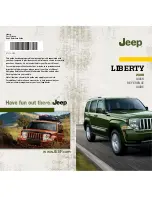
ground. If ingested by a child, contact a physician
immediately. Clean up any ground spills immediately.
Coolant Level
The coolant bottle provides a quick visual method for
determining that the coolant level is adequate. With the
engine idling and warm to normal operating tempera-
ture, the level of the coolant in the bottle should be
between the “ADD” and “FULL” lines, shown on the
bottle.
The radiator normally remains completely full, so there is
no need to remove the radiator cap unless checking for
coolant freeze point or replacing coolant. Advise your
service attendant of this. As long as the engine operating
temperature is satisfactory, the coolant bottle need only
be checked once a month.
When additional coolant is needed to maintain the
proper level, it should be added to the coolant bottle. Do
not overfill.
Points To Remember
NOTE:
When the vehicle is stopped after a few miles (a
few kilometers) of operation, you may observe vapor
coming from the front of the engine compartment. This is
normally a result of moisture from rain, snow, or high
humidity accumulating on the radiator and being vapor-
ized when the thermostat opens, allowing hot coolant to
enter the radiator.
If an examination of your engine compartment shows no
evidence of radiator or hose leaks, the vehicle may be
safely driven. The vapor will soon dissipate.
•
Do not overfill the coolant recovery bottle.
•
Check coolant freeze point in the radiator and in the
coolant recovery bottle. If antifreeze needs to be
added, contents of coolant recovery bottle must also be
protected against freezing.
•
If frequent coolant additions are required, or if the
level in the coolant recovery bottle does not drop when
the engine cools, the cooling system should be pres-
sure tested for leaks.
•
Maintain coolant concentration at 50% HOAT engine
coolant (minimum) and distilled water for proper
corrosion protection of your engine which contains
aluminum components.
MAINTAINING YOUR VEHICLE
297
7
Summary of Contents for 2007 Caliber
Page 2: ......
Page 5: ...INTRODUCTION 5 1...
Page 64: ......
Page 89: ...UNDERSTANDING THE FEATURES OF YOUR VEHICLE 89 3...
Page 90: ...90 UNDERSTANDING THE FEATURES OF YOUR VEHICLE...
Page 91: ...UNDERSTANDING THE FEATURES OF YOUR VEHICLE 91 3...
Page 129: ...Removing Flashlight Three Press Switch UNDERSTANDING THE FEATURES OF YOUR VEHICLE 129 3...
Page 141: ...INSTRUMENT PANEL FEATURES UNDERSTANDING YOUR INSTRUMENT PANEL 141 4...
Page 142: ...INSTRUMENT CLUSTER BASE 142 UNDERSTANDING YOUR INSTRUMENT PANEL...
Page 143: ...INSTRUMENT CLUSTER PREMIUM UNDERSTANDING YOUR INSTRUMENT PANEL 143 4...
Page 203: ...Operating Tips UNDERSTANDING YOUR INSTRUMENT PANEL 203 4...
Page 232: ...232 STARTING AND OPERATING...
Page 279: ...ENGINE COMPARTMENT GASOLINE ENGINES MAINTAINING YOUR VEHICLE 279 7...
Page 345: ...INDEX 10...
Page 360: ...NOTES...
















































